Holy hardcore cooling mods batman! Nice job BC
You are using an out of date browser. It may not display this or other websites correctly.
You should upgrade or use an alternative browser.
You should upgrade or use an alternative browser.
Who Is It That Modifies The Intake Manifold/Intercooler?
- Thread starter sqidd
- Start date
DOB is posting info on a manifold for the GT500. I really hope some of the top dogs racing on here pick it up and post some results up. I know at 26psi I had an IAT2 of 112F, which the 3V guys running other stuff was amazed with. I am upgrading my 3.4 whipple with a Bullseye 83 and a custom hat from Hogan, can't wait to see what that combo does.
Based on what I have seen on the GT500 unit, they should anticipate better, which is crazy. He has posted up some preliminary CAD drawings on DOB Facebook. I hope he has enough volume to justify what he has into bringing this out.
Link for any GT500 guys interested: Department of Boost :: Cooling/Intercoolers
Based on what I have seen on the GT500 unit, they should anticipate better, which is crazy. He has posted up some preliminary CAD drawings on DOB Facebook. I hope he has enough volume to justify what he has into bringing this out.
Link for any GT500 guys interested: Department of Boost :: Cooling/Intercoolers
Looks very similar to Fischer's design. Would like to see some pics, I'd probably be in at $4K on the group buy.DOB is posting info on a manifold for the GT500. I really hope some of the top dogs racing on here pick it up and post some results up. I know at 26psi I had an IAT2 of 112F, which the 3V guys running other stuff was amazed with. I am upgrading my 3.4 whipple with a Bullseye 83 and a custom hat from Hogan, can't wait to see what that combo does.
Based on what I have seen on the GT500 unit, they should anticipate better, which is crazy. He has posted up some preliminary CAD drawings on DOB Facebook. I hope he has enough volume to justify what he has into bringing this out.
Link for any GT500 guys interested: Department of Boost :: Cooling/Intercoolers
Yes I have Fischer Motorsports manifold, single pass intercooler modifications, along with the Fischer trunk tank with a 55GPH Meziere water pump
I like it and believe it works very well. Data logging on the street or during the dyno tuning showed low IAT2s with this set up. I exclusively use the Ford orange anti-freeze in this system, no ice water. On a hot day with IAT1 reaching 160*F in stop and go traffic of NOVA I haven't seen the IAT2 go above 118*F with the tank coolant temperatures floating around 105*F.
The car is a monster and I can't really get the best data logs of IAT2 on the street. I can't get in the throttle and go above 10 psi of boost in 1-2 gear without blowing the tires away. 3rd gear I can spin the tires at 100mph at half throttle and may get to 14-15 psi of boost. So I can't really give you an assessment of how this system cools IAT2 under a long pull at full power and boost
Hey RBB I haven't forgot your offer on the state inspection. I just decided to drive it without one. I thought if they stop me I'm gonna get so many tickets....... what was one more. LOL Maybe next year once the spring weather comes back I'll catch you for that offer.
Hi Bad Company, I been designing my own custom TRUE 1" IC water inlet and outlet to be used for the J2Fab 1" IC mod for my KB Bigun IC. Took me little while to figure that out and have those custom parts 3D printed in aluminum. All these STILL seat below the supercharger belt KB 3.6LC with 3.75" pulley and can be used with the stock 13/14 IC pump at stock location.
I been studying the Shawn Fischer IC mod which is on your car and I truly believe I can further improve it. The rear inlet us -16 AN (1") but my improvement will be -20 AN (1.25") with the front (2) inlets at TRUE1". All this still seat below the KB 3.6LC with 3.75 pulley.
Fischer also has an option to go with a -20 inlet at the rear. I didn't go that route due to I didn't want to try to run that big of a set hoses from through the interior of car. If I was doing a true race car I without a passenger's seat I would have gone to the bigger hoses.Hi Bad Company, I been designing my own custom TRUE 1" IC water inlet and outlet to be used for the J2Fab 1" IC mod for my KB Bigun IC. Took me little while to figure that out and have those custom parts 3D printed in aluminum. All these STILL seat below the supercharger belt KB 3.6LC with 3.75" pulley and can be used with the stock 13/14 IC pump at stock location.
I been studying the Shawn Fischer IC mod which is on your car and I truly believe I can further improve it. The rear inlet us -16 AN (1") but my improvement will be -20 AN (1.25") with the front (2) inlets at TRUE1". All this still seat below the KB 3.6LC with 3.75 pulley.
You're getting into your project deeply with printed aluminum. LOL It is hard to keep from investing money in Hp modifications
This constant rain each weekend is a killer. I've drained the fuel out of her, put 5 fresh gallons of 93 in with StaBill 360 for the winter. I'll have to get with you to let you see this contraption in the spring. If we keep getting the moisture we have been and it gets cold, I think the cars won't move for a while, because we're going to be buried in snow.Kurt, my buddy just asked me a couple months ago what happened to that badass Shelby you wanted me to inspect? Offer still stands any time man, we can just take the hood off and roll over there. I still need to see this beast.
It was a terrible summer/fall in the area. I think we had a grand total of 4 weekends without rain, and 2 of them I was out of town. I made it to the track one time with the new build. Hopefully 2019 is a big improvement....I've got a Gen3 and some other goodies going on this winter so I'm looking forward to it.This constant rain each weekend is a killer. I've drained the fuel out of her, put 5 fresh gallons of 93 in with StaBill 360 for the winter. I'll have to get with you to let you see this contraption in the spring. If we keep getting the moisture we have been and it gets cold, I think the cars won't move for a while, because we're going to be buried in snow.
I'll shoot you a text as spring rolls around man.
Fischer also has an option to go with a -20 inlet at the rear. I didn't go that route due to I didn't want to try to run that big of a set hoses from through the interior of car. If I was doing a true race car I without a passenger's seat I would have gone to the bigger hoses.
You're getting into your project deeply with printed aluminum. LOL It is hard to keep from investing money in Hp modifications
Hi Guys
I posted this in another thread response but it's likely more appropriate here...
To clarify, on our base package we run a -16 in the back and use the stock tubes and a modified neck out the front (equivalent to the cross section of one -16 fitting). This effectively changes the core to a single pass where the entire water column through the core is fresh IC water. The other designs on the market are dual pass. Our base setup in single pass will flow equivalent to or higher depending on the core's water restriction than a -16 dual pass. In addition to the base setup we also offer a -20AN inlet (largest needed for the core) and offer either dual -12AN outlets, dual 1", or dual -16AN outlets... This would flow more than the other systems on the market.
On after market cooling systems, a single pass setup will flow cooler water and lower IAT's because the entire core is flowing fresh water from the pump, rather than a dual pass flowing once through half the core, picking up heat and then flowing back through the other half of the core again once it is already hot. Dual pass makes sense on a radiator, it has merit on a stock IC cooling system and volume which is why Ford designed it that way, however, it does not make sense on higher flowing, larger volume, upgraded systems, especially when running ice water.
Summation: A dual pass -16 in and a -16 out system will flow the same or less than a single pass -16 in and two -12's out. A -20 in and two -16's out will flow the most and single pass is the only way to achieve this.
I have an extremely good snapshot of our MoTeC data showing how well the Hot Water Bypass system works on a mile run. I don't want to step on any other supporting vender's toes or post outside of the forum's policies. My response here may already be pushing site/vender policies. Maybe an admin can advise on if it is acceptable to post the data image and analysis description here or if maybe Bad Company can post it?...
Happy New Year!
Cheers
Hey Shawn, good to see you on, your big single is definitely top shelf, hope to try it out sometimeHi Guys
I posted this in another thread response but it's likely more appropriate here...
To clarify, on our base package we run a -16 in the back and use the stock tubes and a modified neck out the front (equivalent to the cross section of one -16 fitting). This effectively changes the core to a single pass where the entire water column through the core is fresh IC water. The other designs on the market are dual pass. Our base setup in single pass will flow equivalent to or higher depending on the core's water restriction than a -16 dual pass. In addition to the base setup we also offer a -20AN inlet (largest needed for the core) and offer either dual -12AN outlets, dual 1", or dual -16AN outlets... This would flow more than the other systems on the market.
On after market cooling systems, a single pass setup will flow cooler water and lower IAT's because the entire core is flowing fresh water from the pump, rather than a dual pass flowing once through half the core, picking up heat and then flowing back through the other half of the core again once it is already hot. Dual pass makes sense on a radiator, it has merit on a stock IC cooling system and volume which is why Ford designed it that way, however, it does not make sense on higher flowing, larger volume, upgraded systems, especially when running ice water.
Summation: A dual pass -16 in and a -16 out system will flow the same or less than a single pass -16 in and two -12's out. A -20 in and two -16's out will flow the most and single pass is the only way to achieve this.
I have an extremely good snapshot of our MoTeC data showing how well the Hot Water Bypass system works on a mile run. I don't want to step on any other supporting vender's toes or post outside of the forum's policies. My response here may already be pushing site/vender policies. Maybe an admin can advise on if it is acceptable to post the data image and analysis description here or if maybe Bad Company can post it?...
Happy New Year!
Cheers
Fischer also has an option to go with a -20 inlet at the rear. I didn't go that route due to I didn't want to try to run that big of a set hoses from through the interior of car. If I was doing a true race car I without a passenger's seat I would have gone to the bigger hoses.
You're getting into your project deeply with printed aluminum. LOL It is hard to keep from investing money in Hp modifications
I brought my dash 20 in under the passenger seat.
This is a misleading statement. The water is only "fresh" until it has picked enough heat that it no longer has the temp delta it had entering. And then at the point where the water has picked up so much heat where there is no/very little temp delta. Where these points are at depends on discharge temp, water temp, and water speed. But in no situation is it "fresh" all the way through the core. The single pass water will pick up heat at the same measurable rate as a dual pass and they will both have "fresh" water at equal points of IC volume used/traveled through. There is a on paper argument that the slower water speed in a single pass vs a dual pass can extract more heat. But it is offset by the on paper argument that the faster water speed through the core creates more turbulence which reduces the boundary layer increasing heat transfer rate. I have never seen any data to support a single being better than a dual pass or vice versa. I have looked high and low in addition to testing I have performed myself.Hi Guys
This effectively changes the core to a single pass where the entire water column through the core is fresh IC water.
The other designs on the market are dual pass. Our base setup in single pass will flow equivalent to or higher depending on the core's water restriction than a -16 dual pass.
That is an incorrect statement when factoring the core sizes that are being used. There is zero flow rate difference through the IC when comparing single vs dual pass. You would have to run a core volume that is under 25% of what "standard" is to begin to see a flow restriction using a dual pass. And no one is running a core that small.
With a -20AN inletIn addition to the base setup we also offer a -20AN inlet (largest needed for the core) and offer either dual -12AN outlets, dual 1", or dual -16AN outlets...
-Dual 12AN outlets are a 28% restriction in flow.
-Dual 16AN outlets are not a restriction in flow.
On after market cooling systems, a single pass setup will flow cooler water and lower IAT's because the entire core is flowing fresh water from the pump, rather than a dual pass flowing once through half the core, picking up heat and then flowing back through the other half of the core again once it is already hot.
This is an incorrect statement. On paper you can show a gain with the single. But it's so small as to be immeasurable. Under .25deg. In reality if the advantage is there, it's impossible to measure with avilable testing procedures and equipment.
This is correct. But it has nothing to do with how many passes are in play. It is 100% dictated by line size.Summation: A dual pass -16 in and a -16 out system will flow the same or less than a single pass -16 in and two -12's out.
100% not true.A -20 in and two -16's out will flow the most and single pass is the only way to achieve this.
-----------------------------------------------------
In no way am I suggesting that the Fischer Motorsports manifold does not perform very well and a lot better than what is currently available.
I'm not attempting to argue these points. And I won't. My internet policy is to lay out the facts as I know them and then not comment again. Readers can take them or leave them. No amount of arguing has ever changed anyone's mind on the internet.....ever.
My comments/data is based on water flow rig testing, extensive computer modeling which was backed up by a couple of hundred hours on the engine dyno (this allows an incredible control of variables you can't approach when testing with a car) testing different configurations, flow rates, line sizes, core designs, etc.
This is the DOB Spec R manifold on a 3V, 19psi, 730hp on E85, no ice, before I switched over to Ignite 114. My understanding is that the GT500 manifold will be bigger than mine.
At 26 psi and 850 HP, on ignite 114, no ice, my iat2 temp was 112F. Pretty sure the GT500 guys with a 4.0 whipple or turbo hat really pushing boost are gonna be happy.

At 26 psi and 850 HP, on ignite 114, no ice, my iat2 temp was 112F. Pretty sure the GT500 guys with a 4.0 whipple or turbo hat really pushing boost are gonna be happy.
So, I have a pretty decent memory... and intuition. Yep, Sqidd is the same guy (Jason Etter, owner of Department of Boost) that contacted me back in 2016 with his "I'm not trying to bust your balls. If I were I would make this discussion public" BS. Well Jason, here's your chance....
Attached is the contact I have had with Jason (Sqidd) when he reached out in the past, this was our first and only encounter until here. You guys can judge aptitude, knowledge, and motive for yourselves.
We have a high standard of doing things correctly and with responsibility. I call out BS wherever I see it, and feel that those watching should be aware of it. All industries need to be held to higher standards with their claims and what they push; our industry is no different.
Jason, stating something is inaccurate or false doesn't magically make it so. I'm going to make these points as simple as I can for the highest probability of everyone grasping the concepts.
Our base setup in single pass will flow EQUIVALETN TO or higher depending on the CORE"S WATER RESTRICTION than a -16 dual pass. Also Fact.
For the inlet fittings:
Our base setup of a single pass core with a single -16 inlet has equivalent fitting internal cross-sectional area for flow as the other dual pass core setups with a single -16 inlet. Fact.
For the outlet fittings:
Two -12AN fittings equal one -16 fitting.
Our base setup of a single pass core with a dual -12 out has equivalent fitting internal cross-sectional area for flow as the other dual pass core setups with a single -16 out. Fact.
For the core:
Our base setup with a single pass core has twice the cross sectional area for the flow path in the core than the other dual pass core setups because on a dual pass core, half of the available cross section of the core is used for the first pass and the other half of the cross section of the core is used for the second pass. This is all a fact.
Therefore, since the inlet and outlet fittings are equal in cross sectional area for flow, this leaves the variance to the core. If the dual pass system's coolant flow rate is below the coolant flow capacity of half of the core, than our single pass core setup will flow EQUIVALENT to the dual pass core setup. If the dual pass system's coolant flow rate is beyond the coolant flow capacity of half of the core, than our single pass core setup will flow HIGHER than the dual pass core setup. because of flow restriction across the core and the resulting increase in pump head pressure that reduces it's efficiency and flow rate. Fact.
NEWSFLASH! Per Honeywell-Garrett, optimal flow rate of the core is 60 gpm+!….. You stated previously and documented in our attached conversation that you have been unable to flow more than 27gpm though the dual pass configuration. I'm going to go wAy oUt oN a lImB hErE and suggest that this is likely because you are only flowing through HALF the available cross-section of the core and HALF the possible cross-section of the inlet/outlet fittings!!!... Your 27 gpm x2 is 54 gpm… figure in the reduction of head back pressure on the pump due to DOUBLING the flow cross section and I'll bet you it picks up the additional 6 gpm and possibly more!
A side note for those curious... Honeywell Garett cores are one of if not the most efficient and best designs on the market. They were originally designed for commercial aviation air conditioning systems with extremely high design and manufacturing requirements, however, even their cores are prone to failure with inadequate water flow and or inadequate cool coolant flow in extreme (hot and high pressure) conditions. This is due to localized boiling and resulting thermal stress on the core. This issue is more prevalent on lower quality cores and is a common occurrence for high boost race vehicles that increasing the flow rate often cures.
The statement of a single -20 being equivalent in flow to two -16 outlet fittings is correct.
You also left out an important part of my quote: "This would flow more than the other systems on the market." This is referring to the -20 inlet and dual -16 outlets we offer making this statement also Fact.
A dual pass will have more restriction in flow than a single pass regardless of flow volume and rate. Are you really arguing that there is NO increase in friction or pressure drop when flowing through half the cross-sectional area and twice the length of core as a single pass?
I'll say the same thing I said to you before. If I am mistaken of your intentions, please correct me. If your intentions are genuine, my advice is to tailor your approach to new contacts better and let's start over from a clean sheet.[/COLOR][/SIZE][/LEFT]
Attached is the contact I have had with Jason (Sqidd) when he reached out in the past, this was our first and only encounter until here. You guys can judge aptitude, knowledge, and motive for yourselves.
We have a high standard of doing things correctly and with responsibility. I call out BS wherever I see it, and feel that those watching should be aware of it. All industries need to be held to higher standards with their claims and what they push; our industry is no different.
Jason, stating something is inaccurate or false doesn't magically make it so. I'm going to make these points as simple as I can for the highest probability of everyone grasping the concepts.
[bcolor=transparent][/bcolor]
This effectively changes the core to a single pass where the entire water column through the core is fresh IC water.
This is a misleading statement. The water is only "fresh" until it has picked enough heat that it no longer has the temp delta it had entering. And then at the point where the water has picked up so much heat where there is no/very little temp delta. Where these points are at depends on discharge temp, water temp, and water speed. But in no situation is it "fresh" all the way through the core. The single pass water will pick up heat at the same measurable rate as a dual pass and they will both have "fresh" water at equal points of IC volume used/traveled through. There is a on paper argument that the slower water speed in a single pass vs a dual pass can extract more heat. But it is offset by the on paper argument that the faster water speed through the core creates more turbulence which reduces the boundary layer increasing heat transfer rate. I have never seen any data to support a single being better than a dual pass or vice versa. I have looked high and low in addition to testing I have performed myself.
[bcolor=transparent][/bcolor]
This is a very simple concept. When you "dual pass" a core, half of the core has "fresh" coolant flowing INTO it, and the other half of the core has coolant that is warmer flowing INTO it. This is because the coolant flowing into the second pass has already had heat transferred to if from the first pass. A single pass core will cool the IAT more when BOTH HALVES of the core are flowing "fresh", cool coolant into them as opposed to one half flowing "fresh" coolant and the other half flowing already heated coolant.....The other designs on the market are dual pass. Our base setup in single pass will flow equivalent to or higher depending on the core's water restriction than a -16 dual pass.
The other designs on the market are dual pass. Fact.That is an incorrect statement when factoring the core sizes that are being used. There is zero flow rate difference through the IC when comparing single vs dual pass. You would have to run a core volume that is under 25% of what "standard" is to begin to see a flow restriction using a dual pass. And no one is running a core that small.
Our base setup in single pass will flow EQUIVALETN TO or higher depending on the CORE"S WATER RESTRICTION than a -16 dual pass. Also Fact.
For the inlet fittings:
Our base setup of a single pass core with a single -16 inlet has equivalent fitting internal cross-sectional area for flow as the other dual pass core setups with a single -16 inlet. Fact.
For the outlet fittings:
Two -12AN fittings equal one -16 fitting.
Our base setup of a single pass core with a dual -12 out has equivalent fitting internal cross-sectional area for flow as the other dual pass core setups with a single -16 out. Fact.
For the core:
Our base setup with a single pass core has twice the cross sectional area for the flow path in the core than the other dual pass core setups because on a dual pass core, half of the available cross section of the core is used for the first pass and the other half of the cross section of the core is used for the second pass. This is all a fact.
Therefore, since the inlet and outlet fittings are equal in cross sectional area for flow, this leaves the variance to the core. If the dual pass system's coolant flow rate is below the coolant flow capacity of half of the core, than our single pass core setup will flow EQUIVALENT to the dual pass core setup. If the dual pass system's coolant flow rate is beyond the coolant flow capacity of half of the core, than our single pass core setup will flow HIGHER than the dual pass core setup. because of flow restriction across the core and the resulting increase in pump head pressure that reduces it's efficiency and flow rate. Fact.
NEWSFLASH! Per Honeywell-Garrett, optimal flow rate of the core is 60 gpm+!….. You stated previously and documented in our attached conversation that you have been unable to flow more than 27gpm though the dual pass configuration. I'm going to go wAy oUt oN a lImB hErE and suggest that this is likely because you are only flowing through HALF the available cross-section of the core and HALF the possible cross-section of the inlet/outlet fittings!!!... Your 27 gpm x2 is 54 gpm… figure in the reduction of head back pressure on the pump due to DOUBLING the flow cross section and I'll bet you it picks up the additional 6 gpm and possibly more!
A side note for those curious... Honeywell Garett cores are one of if not the most efficient and best designs on the market. They were originally designed for commercial aviation air conditioning systems with extremely high design and manufacturing requirements, however, even their cores are prone to failure with inadequate water flow and or inadequate cool coolant flow in extreme (hot and high pressure) conditions. This is due to localized boiling and resulting thermal stress on the core. This issue is more prevalent on lower quality cores and is a common occurrence for high boost race vehicles that increasing the flow rate often cures.
In addition to the base setup we also offer a -20AN inlet (largest needed for the core) and offer either dual -12AN outlets, dual 1", or dual -16AN outlets...
With a -20AN inlet
Dual 12AN outlets are a 28% restriction in flow.
Your comment on -12 outlets being a restriction when used with a -20 outlet is an attempt to marginalize and manipulate what has been presented. Nowhere did we say that we recommend a -20 inlet in conjunction with two -12 outlets.Dual 16AN outlets are not a restriction in flow.
The statement of a single -20 being equivalent in flow to two -16 outlet fittings is correct.
You also left out an important part of my quote: "This would flow more than the other systems on the market." This is referring to the -20 inlet and dual -16 outlets we offer making this statement also Fact.
On after market cooling systems, a single pass setup will flow cooler water and lower IAT's because the entire core is flowing fresh water from the pump, rather than a dual pass flowing once through half the core, picking up heat and then flowing back through the other half of the core again once it is already hot.
This is an incorrect statement. On paper you can show a gain with the single. But it's so small as to be immeasurable. Under .25deg. In reality if the advantage is there, it's impossible to measure with avilable testing procedures and equipment.
This is not so common "common sense" and logic... and was already addressed above. "Aftermarket Cooling Systems" (Ice water, larger capacity, high flow pump IC coolant systems) negate this argument. Dual pass only has a place in the discussion regarding smaller capacity coolant systems that constantly recirculate their small volumes using ambient air heat exchangers, like the stock setup, hence Ford's design. Their heat exchanger, IC core, and pump flow are all engineered to work in concert. Application largely drives why things are done the way they are... never mind the separate discussion on the notorious GT500s stock IC and coolant system heat soak issues.[/bcolor]
Summation: A dual pass -16 in and a -16 out system will flow the same or less than a single pass -16 in and two -12's out.
Until you run the inlet and outlet fitting sizes up, then the single pass makes all the difference in the world..…This is correct. But it has nothing to do with how many passes are in play. It is 100% dictated by line size.
A dual pass will have more restriction in flow than a single pass regardless of flow volume and rate. Are you really arguing that there is NO increase in friction or pressure drop when flowing through half the cross-sectional area and twice the length of core as a single pass?
A -20 in and two -16's out will flow the most and single pass is the only way to achieve this.
Oh really? Please enlighten us as to how else you are going to get your dual pass system to flow at or anywhere near 60 gpm on the GT500 platform?100% not true.
[bcolor=transparent][/bcolor]
[bcolor=transparent]
[bcolor=transparent]
In no way am I suggesting that the Fischer Motorsports manifold does not perform very well and a lot better than what is currently available.[/bcolor]
I don't think your intentions are to be entirely misleading / dishonest. I personally think that most of the issue here is that you aren't as smart as you think you are and likely feel threatened on a business front. When you couple that with your reading and comprehension issues and a motive to mislead, we land here, where your approach and statements get viewed as hostile and are treated accordingly. I also don't doubt that you've put a lot of effort into figuring out what you think you know, however, I see people draw incorrect conclusions all the time at the track by assuming variables or misunderstandings physics / thermodynamics. As soon as I meet someone that thinks they know it all, I immediately recognize that they aren't bright enough to realize how little they actually know. Personally, the more I learn, the more I realize how complex a subject is and how little of the overall available knowledge on that subject that I possess. Said another way, the more I learn, the more I discover that I don't know.I'm not attempting to argue these points. And I won't. My internet policy is to lay out the facts as I know them and then not comment again. Readers can take them or leave them. No amount of arguing has ever changed anyone's mind on the internet.....ever.
My comments/data is based on water flow rig testing, extensive computer modeling which was backed up by a couple of hundred hours on the engine dyno (this allows an incredible control of variables you can't approach when testing with a car) testing different configurations, flow rates, line sizes, core designs, etc.
I'll say the same thing I said to you before. If I am mistaken of your intentions, please correct me. If your intentions are genuine, my advice is to tailor your approach to new contacts better and let's start over from a clean sheet.[/COLOR][/SIZE][/LEFT]
Attachments
-
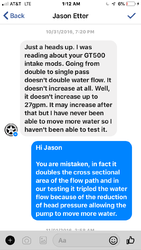 Photo Jan 02, 1 12 10 AM.png133.6 KB · Views: 243
Photo Jan 02, 1 12 10 AM.png133.6 KB · Views: 243 -
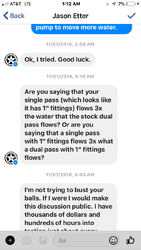 Photo Jan 02, 1 12 22 AM.png133.2 KB · Views: 227
Photo Jan 02, 1 12 22 AM.png133.2 KB · Views: 227 -
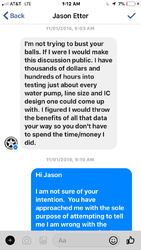 Photo Jan 02, 1 12 36 AM.png126.4 KB · Views: 187
Photo Jan 02, 1 12 36 AM.png126.4 KB · Views: 187 -
 Photo Jan 02, 1 12 42 AM.png123.3 KB · Views: 199
Photo Jan 02, 1 12 42 AM.png123.3 KB · Views: 199 -
 Photo Jan 02, 1 12 49 AM.png132.8 KB · Views: 225
Photo Jan 02, 1 12 49 AM.png132.8 KB · Views: 225 -
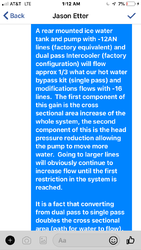 Photo Jan 02, 1 12 59 AM.png139.9 KB · Views: 198
Photo Jan 02, 1 12 59 AM.png139.9 KB · Views: 198 -
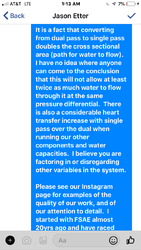 Photo Jan 02, 1 13 12 AM.png138.1 KB · Views: 212
Photo Jan 02, 1 13 12 AM.png138.1 KB · Views: 212 -
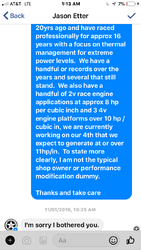 Photo Jan 02, 1 13 23 AM.png138.8 KB · Views: 175
Photo Jan 02, 1 13 23 AM.png138.8 KB · Views: 175
Last edited:
This is the DOB Spec R manifold on a 3V, 19psi, 730hp on E85, no ice, before I switched over to Ignite 114. My understanding is that the GT500 manifold will be bigger than mine.
At 26 psi and 850 HP, on ignite 114, no ice, my iat2 temp was 112F. Pretty sure the GT500 guys with a 4.0 whipple or turbo hat really pushing boost are gonna be happy.
Hi Weatherman,
What ambient temp?
What supercharger discharge temp?
What IC water temp?
Car cooled down?
Looks like a short pull... what are these numbers at the end of the half mile or mile at WOT?
Our HWB kit at 20psi max boost and no ice has, after the burnout, yielded IAT2 of 105F at the hit and 120F MAX at the end of the MILE. Ice and 29psi same car at the end of the mile was 140F IAT2
Just to put things in perspective:
Our HWB kit on a bigger boost mile car.
At the hit:
4.2L KB
189F Engine temp
Ice Water for IC
153F Blower discharge temp
77F IAT2
90F Blower inlet alum case temp
118F Blower outlet alum case temp
At end of the mile:
4.2L KB
189F Engine temp
32psi Boost
Ice Water for IC
432F Blower discharge temp
172F IAT2
92F Blower inlet alum case temp
127F Blower outlet alum case temp
HI Guys
For those interested, attached is a screen shot of a pretty interesting MoTeC data log related to the subject of temperature and thermal management discussed in this thread… it should be pretty eye opening to those not used to seeing the temperatures generated by the higher boosted screws.
The MoTeC log file is from a 4.2L GT500 we built for the TX Mile with a lot of our various systems implemented on it. I wouldn’t call it a “max effort” project as we were limited with time on the build and it can definitely “go bigger”, but it was a pretty serious build with very little budget restriction. The log is from a shake down and licensing run at the mile with a stock intercooler core and intake that had our Hot Water Bypass mods and wastegate boost control mod. This car made right about 1500whp and ran extremely well during our testing, but it got rained out of the only TX mile event it ever went to. We felt it was a 235+ car easy as it was 20 mph faster to the ½ track in its licensing / shakedown runs than the record 215 mph car we ran at previous events. This pass was our 4th pass ever on the new build and was still tuned extremely soft for fueling and timing. We were still shaking it down, getting the owner and co driver up to speed in the car, and neither driver was licensed to go over 200 yet (note the big lift when the driver looked down to check his speed, and a very early shut off that you don’t see in the log).
In the image, check out the engine temps relative to the blower case temps. Normally these would be the same as engine temp at best and usually higher due to the heat soak from the blowers discharge temps. Also see the air temp drop across the IC core (approx. 300*F). These results exhibit how well the thermal management works to keep the intake and blower cool on our systems. Also note the boost ramping boost (boost by gear/rpm control) and the low pressure drop across the intercooler core. In my opinion, our systems works very well.
On other customers’ projects we have built HWB kits for, Lund tuned one of them that ran at the mile and stated the temps he saw in his logs are the lowest he’d seen, stating “whatever you’re doing it’s working, the other cars we run are a lot higher”. Every knowledgeable person that has seen our kits has been complimentary of our work. I see it as a must for performance and reliability. We recognize it isn’t an inexpensive mod, but it performs very well and is cheap insurance from destructive heat soak when compared to the cost of motor rebuilds and downtime associated with them. We have built a handful of HWB kits like these for 4.5L and 4.7L guys, but we don’t have the MoTeC data on them yet that we have on this project.
Every application is different… this is just for example of what is possible with our stuff. These results can and have been improved upon with our latest designs and parts options like the -20 inlet and dual -16 outlets. We will be showcasing more of our GT500 products / systems info with tech details and pictures soon (current site development project).
Cheers!
For those interested, attached is a screen shot of a pretty interesting MoTeC data log related to the subject of temperature and thermal management discussed in this thread… it should be pretty eye opening to those not used to seeing the temperatures generated by the higher boosted screws.
The MoTeC log file is from a 4.2L GT500 we built for the TX Mile with a lot of our various systems implemented on it. I wouldn’t call it a “max effort” project as we were limited with time on the build and it can definitely “go bigger”, but it was a pretty serious build with very little budget restriction. The log is from a shake down and licensing run at the mile with a stock intercooler core and intake that had our Hot Water Bypass mods and wastegate boost control mod. This car made right about 1500whp and ran extremely well during our testing, but it got rained out of the only TX mile event it ever went to. We felt it was a 235+ car easy as it was 20 mph faster to the ½ track in its licensing / shakedown runs than the record 215 mph car we ran at previous events. This pass was our 4th pass ever on the new build and was still tuned extremely soft for fueling and timing. We were still shaking it down, getting the owner and co driver up to speed in the car, and neither driver was licensed to go over 200 yet (note the big lift when the driver looked down to check his speed, and a very early shut off that you don’t see in the log).
In the image, check out the engine temps relative to the blower case temps. Normally these would be the same as engine temp at best and usually higher due to the heat soak from the blowers discharge temps. Also see the air temp drop across the IC core (approx. 300*F). These results exhibit how well the thermal management works to keep the intake and blower cool on our systems. Also note the boost ramping boost (boost by gear/rpm control) and the low pressure drop across the intercooler core. In my opinion, our systems works very well.
On other customers’ projects we have built HWB kits for, Lund tuned one of them that ran at the mile and stated the temps he saw in his logs are the lowest he’d seen, stating “whatever you’re doing it’s working, the other cars we run are a lot higher”. Every knowledgeable person that has seen our kits has been complimentary of our work. I see it as a must for performance and reliability. We recognize it isn’t an inexpensive mod, but it performs very well and is cheap insurance from destructive heat soak when compared to the cost of motor rebuilds and downtime associated with them. We have built a handful of HWB kits like these for 4.5L and 4.7L guys, but we don’t have the MoTeC data on them yet that we have on this project.
Every application is different… this is just for example of what is possible with our stuff. These results can and have been improved upon with our latest designs and parts options like the -20 inlet and dual -16 outlets. We will be showcasing more of our GT500 products / systems info with tech details and pictures soon (current site development project).
Cheers!
[bcolor=transparent] [/bcolor]
Attachments
Hi Weatherman,
What ambient temp?
What supercharger discharge temp?
What IC water temp?
Car cooled down?
Looks like a short pull... what are these numbers at the end of the half mile or mile at WOT?
Ambient temps were in the mid 70's, car was fully warmed up on the dyno, run made was on a dyno. This was one of multiple back to back runs made while tuning the car.
I read your messaging back and forth with Jason, my take away was that he was trying to have a conversation and you shut him down not knowing who he was. Which, I get it, no way for you to know how many hours a guy has on a test rig. Probably only a handful of guys you could talk meaningful intercooler shop with in the Mustang world.
Interesting that Fords Cobrajet team had him helping improve intercooler temps on their car this past year.
I strongly suspect that what both of you have arrived at by different paths is that getting X amount of coolant through the intercooler in X amount of time yields great IAT2 control.
It also illustrates how hard it is for a consumer installed kit to approach the levels achieved by expensive close to one off designs used by guys who need or are willing to pay for the best.
You and Jason having a non-antaganist conversation would be cool and I always like learning more about tech.
Users who are viewing this thread
Total: 2 (members: 0, guests: 2)



